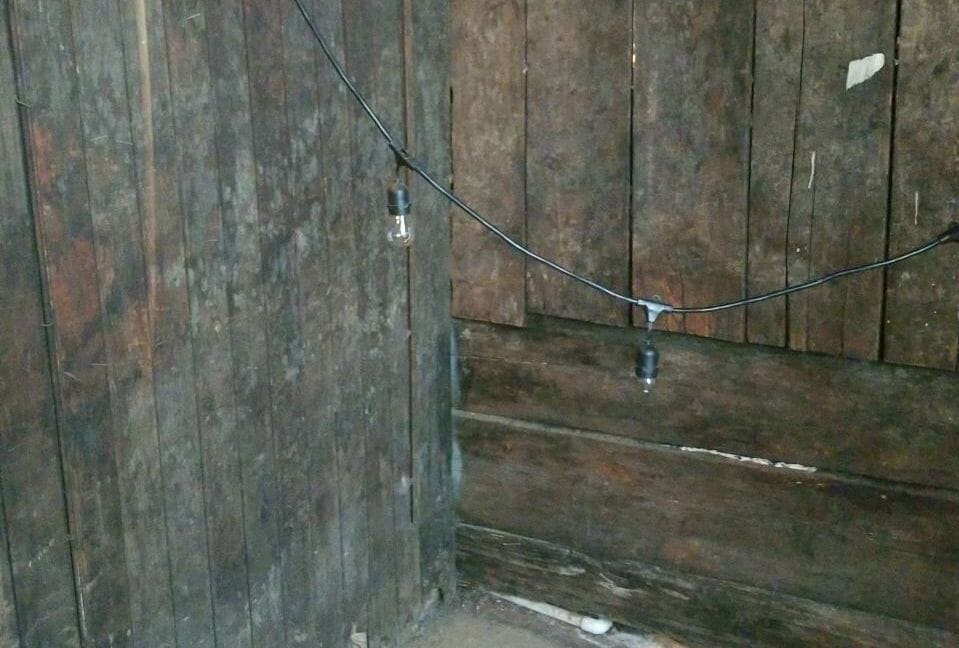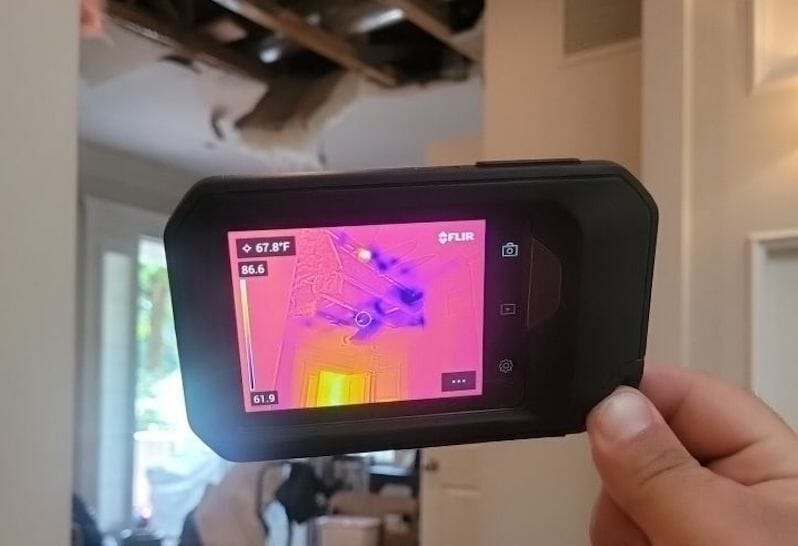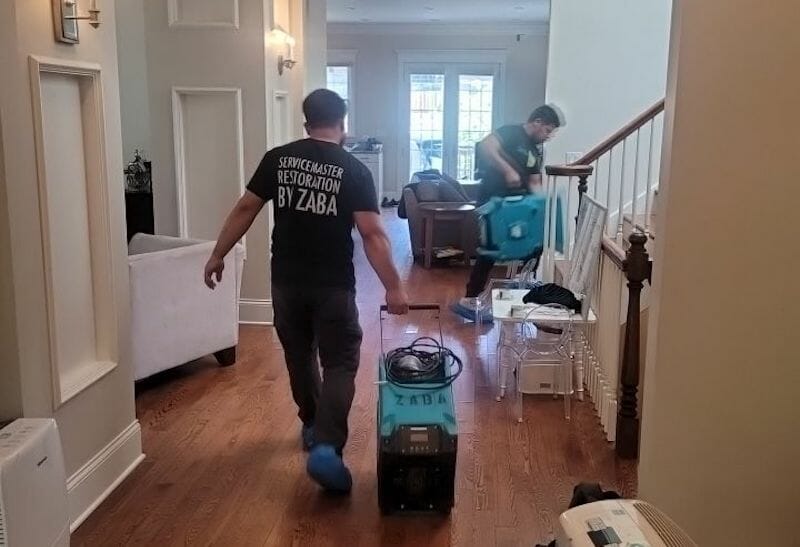A burst pipe, broken appliance, or heavy storm floods your space fast and turns it into a safety hazard.
At ServiceMaster by Zaba, we have years of experience handling water damage across Chicago and the suburbs.
Here’s our expert, step-by-step guide to stopping the damage in its tracks and starting recovery the right way.
Key Takeaways
- Water damage is always an emergency—it can spread fast, ruin your property, and create serious health and safety risks.
- When it happens, shut off the water and power, start with light cleanup wearing protective gear, document the damage, call your insurance, and bring in a certified restoration team right away.
- Local pros like ServiceMaster by Zaba respond 24/7 in Chicago with the tools, training, and experience to clean up the mess and fully restore your space.
When is Water Damage an Emergency?

- Flooded basements – Water from a burst pipe or failed sump pump can damage your foundation and electrical system.
- Attic leaks – Leaking roofs soak insulation and wood, quickly leading to mold and structural damage.
- Sewage backups/toilet overflows – Category 3 water from sewage contains harmful bacteria and viruses, making it a serious health hazard.
- Black mold – Mold spreads fast and releases toxic spores that can harm your health.
- Structural damage – Leaks weaken framing and supports, putting your building at risk of collapse.
- Crumbled drywall – Waterlogged drywall breaks down and can fall, creating safety hazards and more damage.
These situations are especially common in Chicago homes with aging infrastructure or flat-roof buildings that struggle with drainage during downpours.
6 Critical Steps to Take Immediately

1. Shut Off the Main Water Supply
Quickly locate and close your main water valve. Then open nearby faucets to relieve pressure in the system.
This simple action can prevent hundreds of gallons of water from flooding your home in minutes.
Avoid sinks or drains connected to damaged pipes. If you can’t access the main shutoff valve safely, contact a plumber immediately.
Pro Tip: If you’re unsure where to find your shut-off valve, contact the City of Chicago’s Water Management or your local ward office for assistance.
2. Turn Off the Electricity
Cut power to any affected rooms, especially if water has reached outlets, wiring, or appliances.
If you’re not sure it’s safe, wait for a licensed electrician before touching anything.
3. Protect Yourself and Begin Light Cleanup
Once the power is off, put on rubber boots, waterproof gloves, and an N95 mask to guard against contaminants and mold.
Start with light cleanup—mop standing water and remove small soaked items you can safely handle.
Leave heavy lifting and structural damage to the professionals.
Pro tip: Don’t throw anything out yet—your insurance adjuster needs to see the damage, and many items can be restored.
3. Call Your Insurance Company
Contact your homeowners or business property insurance company as soon as possible.
Take clear photos or videos of all visible damage to support your claim.
Provide a detailed description of what happened, when the damage began, and how much of the property is affected.
Pro tip: Many Chicago-area insurance providers work directly with local restoration companies like ServiceMaster by Zaba to simplify the claims process.
4. Contact ServiceMaster by Zaba

Emergency cleanup is not a DIY job. Restoration professionals use commercial-grade equipment and have the training to detect hidden moisture and prevent mold.
Look for IICRC-certified technicians to ensure the highest standards of service.
ServiceMaster by Zaba has IICRC-certified teams that respond within 90 minutes anywhere in Chicago or the surrounding suburbs. Call us now: (773) 647-1985
5. Start the Drying Process
Mold starts growing within 24–48 hours in a damp environment, so you need to act quickly.
You can begin the drying process before the restoration crew arrives by opening windows and interior doors to increase airflow throughout the space.
Use fans in areas that are clear of electrical hazards to start drying wet surfaces. If you have a dehumidifier, turn it on to help remove excess humidity from the air.
Pro tip: Open cabinets and closets to release trapped moisture and prevent mold growth in enclosed areas.
6. Consider Temporary Relocation
Water-damaged properties may have high humidity levels and poor indoor air quality, especially with mold or sewage exposure. Restoration work can be noisy and disruptive.
Emergency water damage cleanup can take days and even weeks, so be patient and consider temporarily relocating.
Pro Tip: Many insurance policies cover temporary living accommodations after a water damage emergency.
How ServiceMaster by Zaba Handles Emergency Water Damage in Chicago

Here’s what happens once we arrive:
1. Inspection & Moisture Mapping
We assess visible and hidden damage using infrared cameras and moisture meters.
This tells us how far water has spread beneath floors, behind walls, and into ceilings.
2. Structural Stabilization
Our technicians respond quickly to address urgent safety concerns, including:
- Collapsing drywall
- Buckled or warped flooring
- Exposed electrical components
- Sagging or leaking ceilings
- Weakened structural supports
We also board up broken windows and tarp roof leaks if needed.
3. Water Extraction
Using high-powered vacuums and truck-mounted pumps, we remove standing water rapidly to prevent further damage and mold growth.
4. Damage Mitigation
We isolate damaged areas and remove materials that can’t be saved.
This may include soggy insulation, flooring, or drywall.
5. Industrial Drying
We place air movers and dehumidifiers to pull moisture from structural materials. This drying phase is closely monitored and adjusted daily.
6. Deep Cleaning & Sanitization
We use EPA-approved disinfectants to clean all affected surfaces.
This step removes bacteria, viruses, and mold spores, making the environment safe again.
7. Content Packout & Cleaning
Personal belongings and furniture are inventoried and packed out to a secure facility.
There, our team professionally cleans, sanitizes, and restores items like electronics, textiles, documents, and more before returning them.
8. Full Restoration
During this last step, we rebuild walls, ceilings, and floors.
We’ve rebuilt hundreds of homes and businesses across Chicago and the suburbs, each with its own unique building codes and challenges.
Your property will be completely restored to its pre-water emergency condition.
Need Emergency Restoration Services in Chicago or Suburbs? We Can Help!
We understand the chaos of a water emergency. That’s why ServiceMaster by Zaba offers 24/7 fast response across Chicago and the suburbs.
Whether you’re dealing with a basement flood in Logan Square or ceiling damage in Skokie, our local teams are ready to help.
We’re on the scene fast with the experienced team and advanced tools to fully restore your home or business to pre-loss condition.
Time matters in water emergencies – call now for 24/7 response: (773) 647-1985
FAQs
How fast does water damage spread?
Immediately. Water is absorbed by porous materials like drywall and wood almost instantly. Within 24 hours, mold can begin to develop.
What does water damage look like?
Look for stains on ceilings, bubbling paint, swollen drywall, warped floors, and musty smells. These are early signs that water damage is occurring behind the scenes.
What causes water damage?
Water damage can result from a wide range of sources. Common causes include:
- burst or leaking pipes
- malfunctioning appliances like washing machines and water heaters
- storm, heavy rain, or flooding
- sewer backups
- roof leaks
Even gradual issues like poor drainage or HVAC condensation can lead to long-term damage if left unchecked.
When should I call the pros?
Call immediately if water is contaminated (sewage or floodwater), if the damage occurred more than 24 hours ago, or if there are signs of structural compromise.
Quick response limits secondary damage.